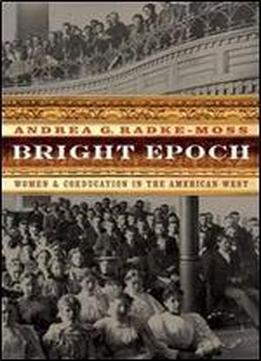
Bright Epoch: Women And Coeducation In The American West (women In The West)
by Andrea G. Radke-Moss /
2008 / English / PDF
2.8 MB Download
With the passage of the Morrill Act in 1862, many states in the Midwest and the West chartered land-grant colleges following the Civil War. Because of both progressive ideologies and economic necessity, these institutions admitted women from their inception and were among the first public institutions to practice coeducation. Although female students did not feel completely accepted by their male peers and professors in the land-grant environment, many of them nonetheless successfully negotiated greater gender inclusion for themselves and their peers.
In Bright Epoch, Andrea G. Radke-Moss tells the story of female students’ early mixed-gender encounters at four institutions: Iowa Agricultural College, the University of Nebraska, Oregon Agricultural College, and Utah State Agricultural College. Although land-grant institutions have been most commonly associated with domestic science courses for women, Bright Epoch illuminates the diversity of other courses of study available to female students, including the sciences, literature, journalism, business commerce, and law. In a culture where the forces of gender separation constantly battled gender inclusion, women found new opportunities for success and achievement through activities such as literary societies, athletics, military regiments, and women’s rights and suffrage activism. Through these venues, women students challenged nineteenth-century gender limitations and created broader definitions of female inclusion and participation in the land-grant environment and in the larger American societyWith the passage of the Morrill Act in 1862, many states in the Midwest and the West chartered land-grant colleges following the Civil War. Because of both progressive ideologies and economic necessity, these institutions admitted women from their inception and were among the first public institutions to practice coeducation. Although female students did not feel completely accepted by their male peers and professors in the land-grant environment, many of them nonetheless successfully negotiated greater gender inclusion for themselves and their peers.
In Bright Epoch, Andrea G. Radke-Moss tells the story of female students early mixed-gender encounters at four institutions: Iowa Agricultural College, the University of Nebraska, Oregon Agricultural College, and Utah State Agricultural College. Although land-grant institutions have been most commonly associated with domestic science courses for women, Bright Epoch illuminates the diversity of other courses of study available to female students, including the sciences, literature, journalism, business commerce, and law. In a culture where the forces of gender separation constantly battled gender inclusion, women found new opportunities for success and achievement through activities such as literary societies, athletics, military regiments, and womens rights and suffrage activism. Through these venues, women students challenged nineteenth-century gender limitations and created broader definitions of female inclusion and participation in the land-grant environment and in the larger American society.











